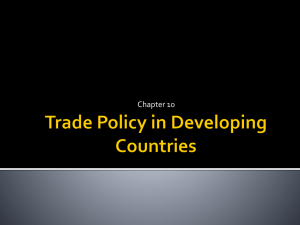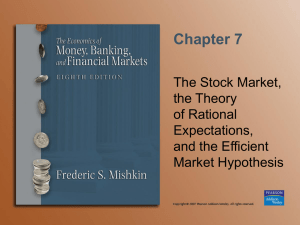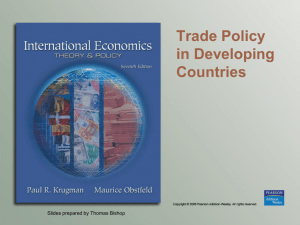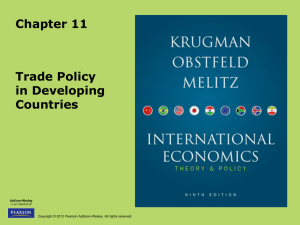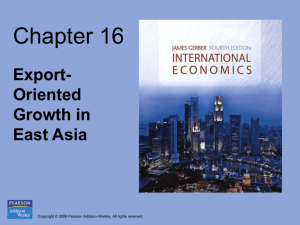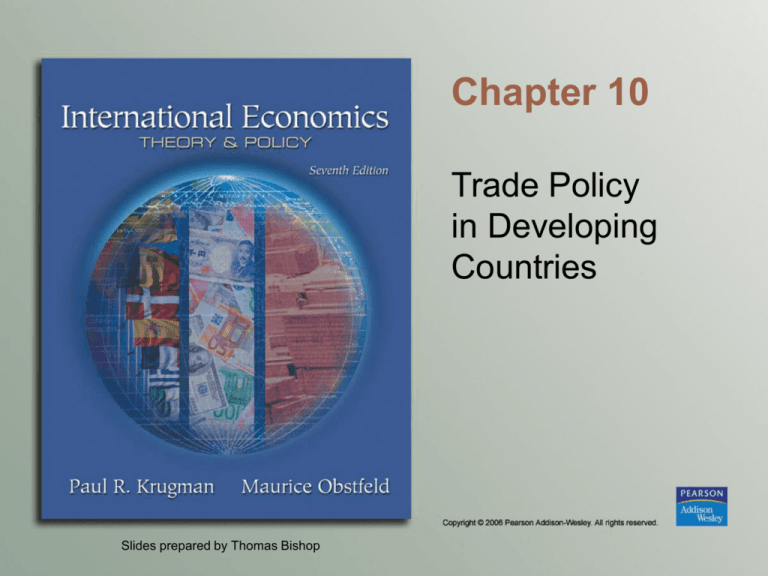
Chapter 10
Trade Policy
in Developing
Countries
Slides prepared by Thomas Bishop
Introduction
Copyright © 2006 Pearson Addison-Wesley. All rights reserved.
10-2
Import Substituting Industrialization
• Import substituting industrialization was a
trade policy adopted by many low and middle
income countries before the 1980s.
• The policy aimed to encourage domestic
industries by limiting competing imports.
• It was often accompanied with the belief that
poor countries would be exploited by rich
countries through international financial
markets and trade.
Copyright © 2006 Pearson Addison-Wesley. All rights reserved.
10-3
Import Substituting Industrialization (cont.)
Copyright © 2006 Pearson Addison-Wesley. All rights reserved.
10-4
Import Substituting Industrialization (cont.)
• The principal justification of this policy was/is
the infant industry argument:
Countries may have a potential comparative
advantage in some industries, but these industries
can not initially compete with well-established
industries in other countries.
To allow these industries to establish themselves,
governments should temporarily support them
until they have grown strong enough to compete
internationally.
Copyright © 2006 Pearson Addison-Wesley. All rights reserved.
10-5
Problems With the
Infant Industry Argument
1. It may be wasteful to support industries now
that will have a comparative advantage in
the future.
2. With protection, infant industries may never
“grow up” or become competitive.
3. There is no justification for government
intervention unless there is a market failure
that prevents the private sector from
investing in the infant industry.
Copyright © 2006 Pearson Addison-Wesley. All rights reserved.
10-6
Infant Industries and Market Failures
•
Two arguments for how market failures
prevent infant industries from becoming
competitive:
1. Imperfect (financial) capital markets
Because of poorly working financial laws and
markets, new industries are not allowed to borrow
as much as they need, which results in restricted
economic growth.
If creating better functioning laws and markets is
not feasible, then high tariffs would be a secondbest policy to increase profits for new industries,
leading to more rapid growth.
Copyright © 2006 Pearson Addison-Wesley. All rights reserved.
10-7
Infant Industries
and Market Failures (cont.)
2. The problem of appropriability
Firms may not be able to privately appropriate the
benefits of their investment in new industries
because those benefits are public goods.
The knowledge created when starting an industry
may be not appropriable (may be a public good)
because of a lack of property rights, or
externalities.
If adequate property rights are not feasible, then
high tariffs would be a second-best policy to
encourage growth in new industries.
Copyright © 2006 Pearson Addison-Wesley. All rights reserved.
10-8
Trade Liberalization (cont.)
Copyright © 2006 Pearson Addison-Wesley. All rights reserved.
10-9
Copyright © 2006 Pearson Addison-Wesley. All rights reserved.
10-10
Trade Liberalization (cont.)
But unstable macroeconomic policies and financial
crises contributed to slower growth since the
1980s.
Other countries like India have grown faster since
liberalizing trade in the 1980s, but it is unclear to
what degree liberalized trade contributed to
growth.
Trade liberalization has contributed to income
inequality in some countries, as Factor Proportions
+ ‘Dualism’ models predict.
• Arthur Lewis’s Model of ‘Dualistic Economy’
• Arthur Lewis’s Nobel Lecture
Copyright © 2006 Pearson Addison-Wesley. All rights reserved.
10-11
Export Oriented Industrialization
• Instead of import substituting industrialization,
several countries in East Asia adopted
trade policies that promoted exports in
targeted industries.
Japan, Hong Kong, Taiwan, South Korea,
Singapore, Malaysia, Thailand, Indonesia and
China are countries that have experienced rapid
growth in various export sectors and rapid
economic growth in general.
These economies or a subset of them are
sometimes called “high performance Asian
economies”.
Copyright © 2006 Pearson Addison-Wesley. All rights reserved.
10-12
Export Oriented Industrialization (cont.)
• These high performance Asian economies
have generated a high volume of exports and
imports relative to total production.
By this standard, these economies are
“open economies”.
• But it is debatable to what degree these
economies established “free trade”.
Although evidence suggests that these economies
did have less restricted trade than other low and
middle income countries, some trade restrictions
were still in effect during different times.
Copyright © 2006 Pearson Addison-Wesley. All rights reserved.
10-13
Export Oriented Industrialization (cont.)
Copyright © 2006 Pearson Addison-Wesley. All rights reserved.
10-14
Industrial Policies in East Asia
• Some East Asian economies have
implemented industrial policies: policies
intended to promote certain industries.
Examples of industrial policies include not only
tariffs, import restrictions, and export subsidies for
import-competing industries and export industries,
but also policies like subsidized loans for industries
and subsidized research and development.
• But not all high performance Asian economies
implemented these policies, and the ones that
did had a wide variety of policies.
Copyright © 2006 Pearson Addison-Wesley. All rights reserved.
10-15
Industrial Policies in East Asia (cont.)
• There is little evidence that countries with
industrial policies had more rapid growth in
the targeted industries than those that did not.
• There is some evidence that industrial policies
failed: chemicals, steel, automobiles were
promoted by the South Korean government in
the 1970s,
but the polices were later abandoned because
they were too expensive and did not produce
desired growth.
Copyright © 2006 Pearson Addison-Wesley. All rights reserved.
10-16
HPAEs’ Industrial Policy
• Crucial element may be strong state in
the sense of the late Mancur Olson
(resistant to corruption).
• Perhaps cultural also – Confucianinspired ‘bureaucratic virtue’, in the
sense of the late John Fei .
Copyright © 2006 Pearson Addison-Wesley. All rights reserved.
10-17





